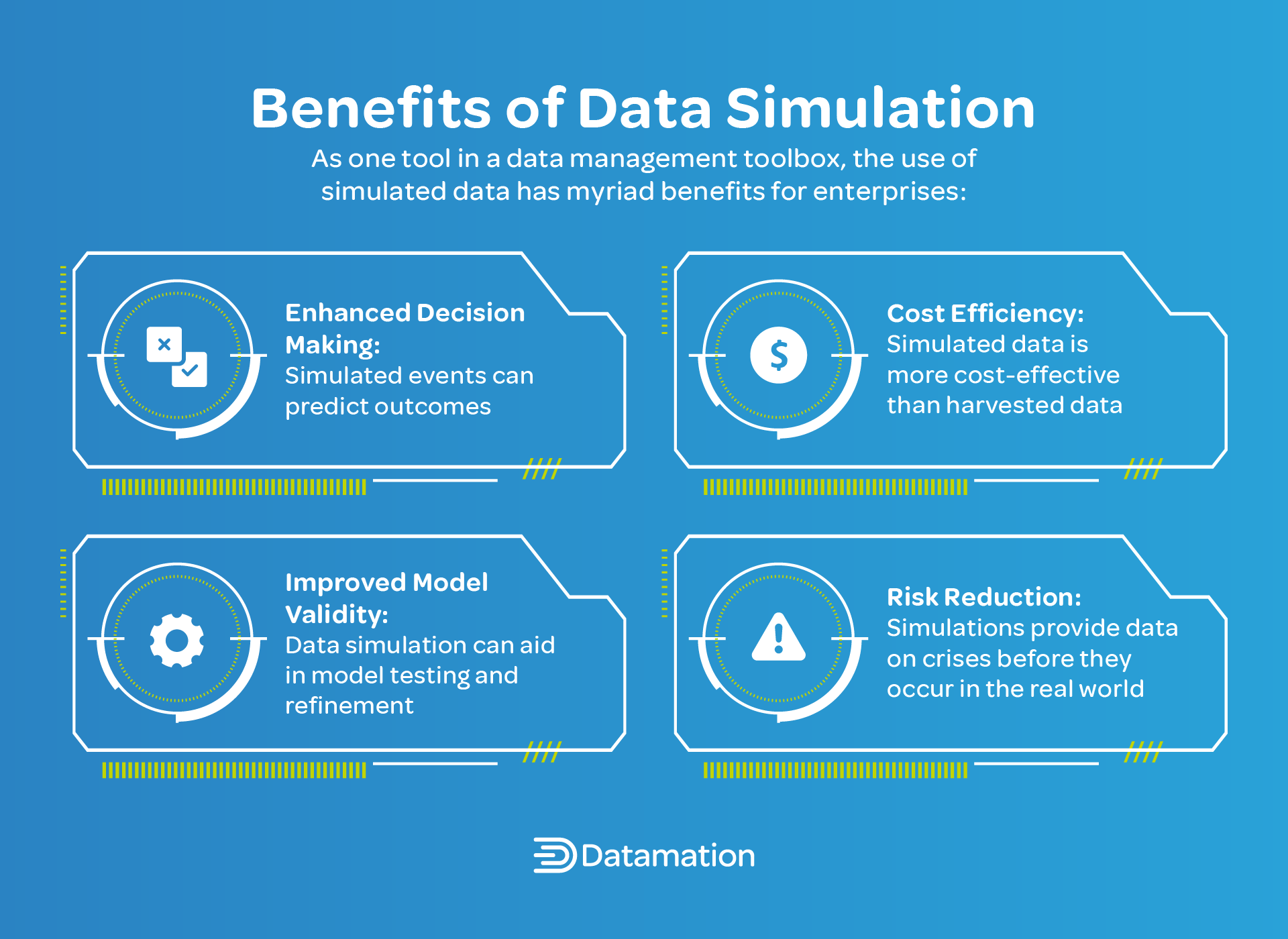Data simulation is the process of generating synthetic data that closely mimics the properties and characteristics of real-world data. Simulated data has the advantage of not needing to be collected from surveys or monitoring software or by scraping websites—instead, it’s created via mathematical or computational models, offering data scientists, engineers, and commercial enterprises access to training data at a fraction of the cost. This article explores the different types of data simulation as well as its uses and limitations.
Jump to:
- Data Simulation Features
- Benefits of Data Simulation
- Data Simulation Use Cases
- Types of Data Simulation Models
- Data Simulation Software Providers
- Bottom Line: What Is Data Simulation?
Featured BI Solutions
Yellowfin
Yellowfin is an embedded analytics and BI platform that combines action based dashboards, AI-powered insight, and data storytelling. Connect to all of your data sources in real-time. Robust data governance features ensure compliance. Our flexible pricing model is simple, predictable and scalable. Easily configure Yellowfin to allow multiple tenants within a single environment. Bring your data to life with beautiful, interactive visualizations that improve decision-making.
Salesforce Data Cloud
Activate all your customer data across Salesforce applications with Data Cloud. Empower teams to engage customers, at every touchpoint, with relevant insights and contextual data in the flow of work. Connect your data with an AI CRM to empower teams to act on relevant data and insights from your existing Salesforce processes and applications.
Zoho Analytics
Finding it difficult to analyze your data which is present in various files, apps, and databases? Sweat no more. Create stunning data visualizations, and discover hidden insights, all within minutes. Visually analyze your data with cool looking reports and dashboards. Track your KPI metrics. Make your decisions based on hard data. Sign up free for Zoho Analytics.
Data Simulation Features
Simulated data can be used to help validate and test complex systems before applying them to authentic data. Simulated data is also complete, and rarely has any gaps or inconsistencies, making it suitable for checking the validity and quality of an analytics system under ideal conditions. While this all can be done using real-life data, with data simulation it comes at a fraction of the cost, and without all the legal and ethical concerns that may arise in handling and storing user data.
Data simulations are attractive to individuals, teams, and enterprises that work with data for myriad reasons beyond just affordability. Its features can be considered in three main areas—flexibility, scalability, and replicability:
- Flexibility. Since the data is manufactured, it can be adjusted to simulate a wide range of scenarios and conditions without ethical constraint, allowing a system to be studied in more depth. This is particularly useful when testing out large-scale simulation models and predictive models. It’s also of benefit when visualizing complex data, making it possible to test for accuracy in extreme situations.
- Scalability. In addition to data quality, data volume plays a critical role in training machine learning and artificial intelligence models. The scalability of simulated data elevates its value for such use cases—since the data is artificial, it can be generated as needed to reflect the randomness and complexity of real-world systems.
- Replicability. Similar circumstances and conditions can be reproduced in a different simulated dataset to ensure consistency in testing. This consistency is crucial for validating models and hypotheses, as it allows you to test them repeatedly and refine them based on the results.
Benefits of Data Simulation
Data simulation is just one tool in an enterprise’s larger data management toolbox. Depending on the use cases, there are numerous benefits to using it in the place of actual data—here are the most common.
Enhanced Decision Making
Data simulation can inform decision-making by simulating various conditions or events and predicting outcomes based on actions. This provides insight into hypothetical scenarios, allowing for the creation of suitable protocols for all possibilities.
Cost Efficiency
Using data simulation instead of harvested data is more cost-effective, as it reduces the need for physical testing and active data collection. Simulating different scenarios and observing their outcomes provides valuable insights without the need for costly and labor-intensive data collection efforts.
Improved Model Validity
Data simulation can aid in model testing and refinement. Creating a virtual representation of a real-world system makes it possible to test different models and refine them based on the results, leading to more accurate models that are better at predicting scenarios in great detail.
Risk Reduction
Data simulation can provide data on crises and potential issues, allowing organizations to identify pitfalls or challenges before they occur in the real world. This foresight can help mitigate risks and avoid costly mistakes.
Learn the best practices for effective data management.
Data Simulation Use Cases
Data simulation can be used in numerous applications across a wide variety of industries. But some industries rely more on data than others, making data simulation particularly beneficial for them.
Finance
In the finance industry, data simulation is primarily used for risk assessment and investment portfolio simulations. Analysts can test different scenarios to gauge potential risks and returns associated with a particular transaction or investment strategy. This helps them make more informed investment decisions and manage client portfolios more effectively.
Healthcare
Data simulation can be used in healthcare to train models for drug testing and epidemiological predictions. Data mimicking patterns of diseases spreading, for example, enables epidemiologists and healthcare professionals to estimate their impact and plan response plans accordingly. Drug simulations provide the opportunity to assess a drug’s efficacy and safety before beginning human trials.
Retail and Marketing
Data simulation can be used to predict customer behavior and optimize stock for purchasing trends in retail and e-commerce. By simulating customer behavior, retailers and marketers can predict purchasing trends and optimize stock levels accordingly, leading to improved customer satisfaction and increased profits.
Types of Data Simulation Models
There are multiple types of data simulation models, each with its own unique features and capabilities. Here are the most common:
- Monte Carlo simulations. This type of simulation uses random sampling to obtain results for uncertain situations and is widely used in finance, physics, and engineering to model complex systems and predict behavior.
- Agent-based modeling. This type of simulation focuses on the actions and interactions of individual, autonomous agents within the data systems and is particularly useful for studying complex systems where the behavior of the system as a whole is influenced by the behavior of individual components.
- System dynamics. System dynamics helps to understand non-linear feedback loops in more complex systems and is often used in economics, environmental science, and public policy to simulate complex systems and predict their behavior.
- Discrete-event simulations. These models focus on individual events in the system and how they affect the outcome, and are widely used in operations research, computer science, and logistics to simulate processes and systems.
Learn more: Data Modeling vs. Data Architecture
Data Simulation Software Providers
Various providers offer data simulation solutions, including commercial software such as MATLAB, Simul8, and AnyLogic Cloud. These tools provide a wide range of features, including graphical user interfaces, scripting languages, and extensive libraries of mathematical and statistical functions.
Open-source data simulation solutions often come in the form of libraries in languages such as Python and R. They’re freely available, widely used in the scientific community, and offer extensive libraries of mathematical and statistical functions. Because they’re highly customizable, they can be tailored to specific needs. Other open source simulation tools include OpenModelica, OpenSimulator, and Logisim.
Bottom Line: What Is Data Simulation?
Data simulation is a powerful tool for studying complex systems and predicting their behavior. It lets you simulate a wide range of scenarios, predict their outcomes, and test different models and hypotheses. Whether you’re a data scientist, a business leader, or a policy maker, data simulation can provide you with the insights you need to make informed decisions.
By using data simulation, you can enhance your decision-making, improve your models, and reduce your risks. With its flexibility, scalability, and replicability, data simulation is a valuable tool for anyone interested in understanding complex systems and making accurate predictions.
Read What is a Digital Twin? to learn how enterprises use virtual environments as another means of simulating real world conditions to test and monitor systems under controlled conditions.







